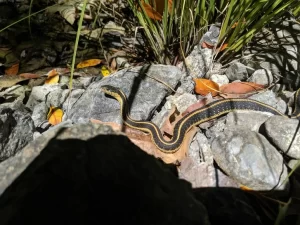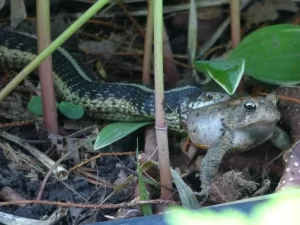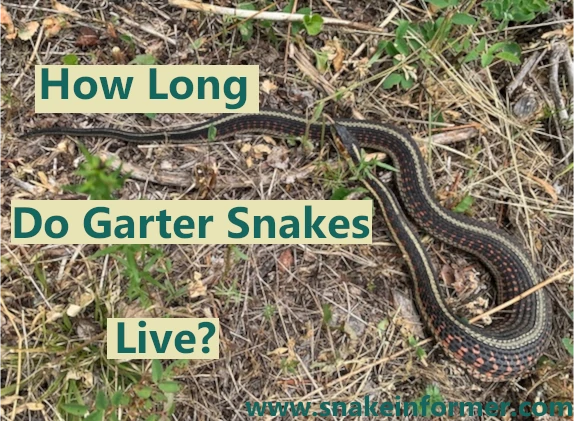Garter snakes are capable of living longer lives than most people think. Their lifespan is influenced by several factors, but captive garter snakes typically live longer than those in the wild.
Garter snakes typically live between 2 – 4 years in the wild – with some individuals living up to 10 years. In captivity, they can live much longer as most of their natural threats are eliminated. Some can live up to 15 years, or even longer.
There are approximately 35 recognized species of garter snakes, and the lifespan can vary depending on the species.
The Lifespan of 10 Garter Snake Species
As earlier mentioned, how long a garter snake lives is influenced by several factors.
For wild garter snakes, their lifespan will depend on the environment they live in and, the dangers they have to deal with.

Their conditions are often not optimal, so most wild garter snakes do not live to their full capability.
In captivity, how long garter snakes live is mainly dependent on how well their owners take of them.
Below Is a Table That Shows Approximately How Long 10 Garter Snake Species Live.
Scientific Name |
Common Name |
Wild Lifespan |
Captive Lifespan |
|---|---|---|---|
| Thamnophis sirtalis | Common Garter Snake | 4–6 years | 8–12 years |
| Thamnophis radix | Plains Garter Snake | 3–5 years | 7–10 years |
| Thamnophis elegans | Western Terrestrial Garter Snake | 4–6 years | 8–11 years |
| Thamnophis marcianus | Checkered Garter Snake | 3–5 years | 8–10 years |
| Thamnophis sauritus | Ribbon Snake | 3–4 years | 6–8 years |
| Thamnophis butleri | Butler’s Garter Snake | 3–5 years | 6–9 years |
| Thamnophis ordinoides | Northwestern Garter Snake | 4–5 years | 7–10 years |
| Thamnophis cyrtopsis | Blackneck Garter Snake | 3–5 years | 6–9 years |
| Thamnophis hammondii | Two-striped Garter Snake | 3–4 years | 6–8 years |
| Thamnophis proximus | Western Ribbon Snake | 3–4 years | 6–8 years |
Keep in mind that many of these numbers are not set in stone. Figures recorded in the scientific literature may vary slightly due to regional variation.
Also, scientists rarely record longevity information, because it requires long-term care (and good record-keeping) of the species under study.
Some garter snake species have very limited long-term studies on their longevity.
Individual garter snakes may be able to live longer than the maximum longevity recorded for their species (under optimal conditions).
Garter Snake Lifespan: Wild vs Captive
In the wild, garter snakes have to deal with many problems that are eliminated when kept in captivity.
Captive garter snakes, on the other hand, do not deal with the same problems – or encounter the same challenges as those in the wild.
For this reason, captive garter snakes will almost always outlive wild garter snakes of the same species, provided they are given proper care.
Factors That Influence the Lifespan of Garter Snakes’ in the Wild
Several things influence how long a wild garter snake will live.
1. Presence of Predators
In the wild, garter snakes have many predators.
They are preyed on by hawks, owls, crows, eagles, raccoons, foxes weasels, large predatory fish, and even larger snakes such as Kingsnakes.
An estimated 80% of all wild garter snakes do not even live to sexual maturity.
If a garter snake lives in an area where it is surrounded by predators, it will most likely not live very long.
On the other hand, if a wild garter snake lives in an area with very few predators, it may be able to live longer.
2. Availability of Food
Like us humans, garter snakes need to eat a balanced diet to remain strong and healthy.
They get all the nutrition they need from the wide variety of prey they eat. If there is an abundance of food where a garter snake lives, it can live for a long time.

However, if a garter snake lives in an area where it finds it hard to find food to eat, the snake is unlikely to live a long life.
3. Disease & Injury
Snakes can suffer from a variety of illnesses and parasitic infections. They are particularly vulnerable as they age and their immune systems weaken.
A garter snake developing an illness, or getting a parasitic infection can dramatically reduce its lifespan.
In addition, a wild garter snake getting an injury could be fatal. If the injury doesn’t kill it directly, it could reduce its ability to find food, or escape predators.
4. Climate
If a garter snake lives in an environment where the extreme cold in the winter, and extreme heat/dryness in the summer, it could affect its lifespan.
Also, if the weather provides unfavorable conditions to snakes (for example, long dry spells), most garter snakes could live shorter lives.
5. Human Activity
Human activity affects a lot of wild animals, garter snakes included.
Loss of habitat due to clearing of land and development can affect the lifespan of most garter snakes.
In addition, humans dump waste and toxic liquids in creeks and other water bodies that snakes rely on.
Factors That Affect a Garter Snake’s Lifespan in Captivity
It can be difficult for someone to care for a garter snake for several years without a single accident, or even a brief period of neglect.
Something as simple as a snake escaping its enclosure could be fatal if the snake is not found quickly enough.
Due to this, many captive garter snakes do not live to their maximum lifespan.
1. Housing & Enclosure
A captive garter snake will need a habitat that very closely replicates its natural environment. Failing to provide this will compromise the welfare of the snake.
Failing to meet the specific housing requirements of a captive garter snake can dramatically affect its life span.
2. Diet
In the wild, garter snakes can get all the nutrients they need from the wide variety of prey they eat. In captivity, their diet is only limited to a few things.
If a captive garter snake is given a low-nutrient diet, it could develop health problems such as metabolic bone disease – and many other conditions that will negatively affect its life span.
It could also lead to the snake having a weakened immune system.
This weakened immune system would then make it possible for opportunistic infections to cause serious, sometimes and sometimes, fatal illnesses.
3. Accidents
Sometimes, things go wrong. For beginners, this is usually due to poor knowledge. But even for the experienced, accidents still happen.
One of the most common accidents is a snake escaping from its enclosure.
An escaped garter snake may starve to death if is not found quickly enough.
Another accident could be a malfunctioning equipment leading to stress on the snake.
The prevalence of accidents means many captive garter snakes die before they can live to their maximum age.
5. Neglect
Captive snakes need ongoing care. If garter snakes are neglected for long periods, it could be harmful, or even fatal to the snake.
Also, neglect often leads to dirt and debris building up in the snake’s enclosure. A dirty environment is a perfect place for bacteria and fungi to build up.
This can lead to a garter snake developing skin lesions and other infections, negatively affecting its lifespan.
Conclusion
Garter snakes can be very long-lived.
Captive garter snakes often live longer than those in the wild, but this is not always the case in reality.
This is mainly because caring for captive snakes is not easy, so mistakes and accidents frequently happen.
If you want to enjoy a decade, or even two, with your garter snake, then giving it proper care is very important.
Sources:
Nguyen, A. M., B. D. Todd, and B. J. Halstead. 2023. Survival and establishment of captive-reared and translocated giant garter snakes after release. Journal of Wildlife Management 87:e22374. https://doi.org/10.1002/jwmg.22374
Hi, my name is Ezra Mushala, i have been interested animals all my life. I am the main author and editor here at snakeinformer.com.

